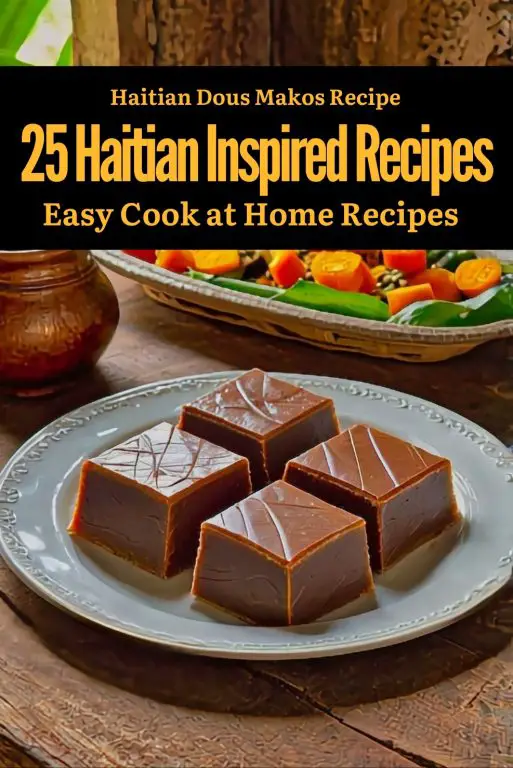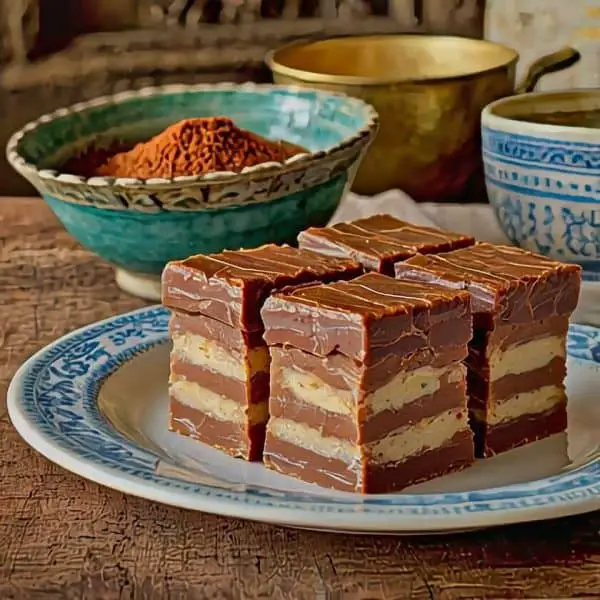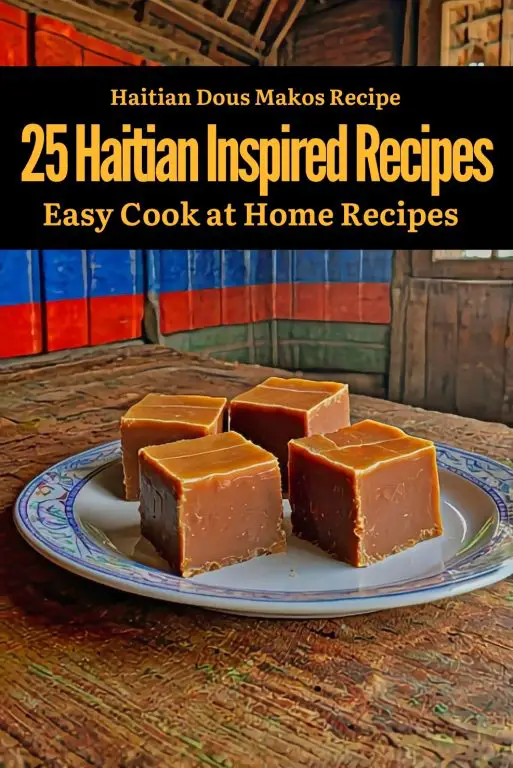Haitian Dous Makos recipe was one of the treats I found on my food tour in Haiti. Sweet and layered, the Haitian Dous Makos is like fudge with a tropical twist reflecting the local culinary heritage.
A trip to a Haitian farmer’s market made me realize how important it is to use fresh, local ingredients in dishes like Haitian Dous Makos. People crowded into the market, where stalls were stocked with fresh foods, spices and other items Haitian cooks can not live without.
The most important ingredients in the Haitian Dous Makos recipe were granulated sugar, nutmeg, ground cinnamon and vanilla extract. They give Dous Makos its taste, and getting them locally keeps them as fresh as possible. The locally made vanilla extract smelled strong, unlike the watered down vanilla extracts you can buy in shops. The nutmeg and cinnamon, ground from newly dried spices, gave the mix a scent and strength that pre-ground spices can not match.
Evaporated milk and sweetened condensed milk are also produced in Haiti and form the base of the Haitian Dous Makos. If these dairy products were bought at a shop some time ago, they may not have created the treat as full of flavor as the dessert we made.
The quality of the ingredients was evident at the end result. Every bite of the Haitian Dous Makos was sweet and hot. The creaminess of the milk complemented the heat. The layers, whose flavors slightly changed as the spice mixture was changed, were visually and taste-wise appealing and showed just how creative Haitian food can be.
This food tour wasn’t just about trying traditional Haitian dishes; It was also about learning how they are made. Getting ingredients from the area farmer’s market made the Haitian Dous Makos recipe taste better and helped the local business. This is one example of a sustainable cooking and eating method.
This hands-on experience with the Haitian Dous Makos recipe gave me material for my food blog. It’s a way of showing how important local products are in traditional recipes and how great Haitian food culture is.
Ingredients For the Haitian Dous Makos recipe
Evaporated Milk
Sweetened Condensed Milk
Granulated Sugar
Water
Vanilla Extract
Ground Cinnamon
Ground Nutmeg
Salt
Cornstarch
Cooking Instructions For the Haitian Dous Makos recipe
- In a large saucepan, combine the evaporated milk, sweetened condensed milk, sugar, water, vanilla extract, cinnamon, nutmeg, and salt. Stir well to combine.
- Heat the mixture over medium heat, stirring occasionally until the sugar has dissolved and the mixture starts to boil. Reduce the heat to low and let the mixture simmer for about 45 minutes, stirring occasionally. The mixture will thicken and darken in color.
- In a separate bowl, whisk together the cornstarch and water until smooth. Slowly pour the cornstarch mixture into the saucepan while stirring constantly.
- Let the mixture simmer for an additional 10-15 minutes, stirring occasionally, until it thickens to a pudding-like consistency.
- Remove the saucepan from the heat and let the mixture cool for a few minutes.
- Pour the mixture into a greased 8×8 inch baking dish and smooth out the top. Let the mixture cool to room temperature, then refrigerate for at least 4 hours or overnight.
- Once the mixture has set, cut it into squares and serve.
10 Reasons I Love Haitian Food
1. Rich Flavors and Diverse Flavors: Haitian food is usually complicated and bold, using an assortment of herbs and spices. Incorporating savory and aromatic tastes, each meal is a sensory treat. Using ingredients like garlic, thyme, Scotch bonnet peppers and cloves gives this a taste that you simply will not find anywhere.
2. Cultural Heritage: Haitian cuisine reflects the nation’s cultural past and also consists of African, French, Taino and Spanish influences. This diverse heritage is reflected in the dishes and techniques of cooking, making each meal a culinary journey through history. Haitian food is like tasting a piece of the nation’s culture and traditions.
3. Comfort Food at Its Best: Lots of Haitian dishes are hearty and filling, including soup joumou and bouillon. These meals are usually shared together with friends and family. The comforting food and sharing is what makes it a real heartwarming experience.
4. Use of Fresh Ingredients Haitian cuisine utilizes fresh, local ingredients which add flavor and provide a healthy meal. From fresh veggies and herbs to meats and seafood, quality ingredients are part of the main reason Haitian food tastes good and is good for you.
5. Versatility of Plantains: The most used component in Haitian food preparation is the plantain. It might be fried, boiled, baked or mashed. Foods like banan peze (fried plantains) and labouyi banan (plantain porridge) showcase the versatile staple.
6. Unique Spice Blends: A crucial component in many Haitian food items is the distinctive spice combination referred to as epis. Made of garlic, bell peppers, onions, parsley, thyme along with other ingredients it’s used as the base for marinades, soups and stews. The flavorful and aromatic profile of epis makes every dish it touches uniquely Haitian.
7. Dishes with Diverse Seafood: As an island nation, Haiti has lots of fresh seafood. Dishes such as poisson gros sel (salted fish) and lalo (jute leaves cooked with crab or shrimp) demonstrate the range of seafood and also the methods they’re prepared. These dishes are flavorful and showcase the sea.
8. Emphasis on Community and Sharing:Haitian meals are frequently shared by loved ones and friends who share food and stories. This emphasis on togetherness makes dining more meaningful and enjoyable, bringing people together over food.
9. Bold and Spicy Flavors: Haitian food tends to be spicy and hot. Scotch bonnet peppers and pikliz (spicy pickled veggies) add a fiery kick to many meals. This particular spiciness coupled with other flavors is a hallmark of the cuisine.
10. Celebration of Traditions: A few Haitian dishes are traditional and are prepared for special occasions and celebrations. As an example, soup joumou is served on New Year’s Day to celebrate Haitian independence. Preparation and sharing of these traditional foods are a way of preserving Haitian culture.
Finding the Best Food in Haiti
Finding the best food in Haiti is a delightful journey through bustling markets, street food stalls and small family restaurants. Haitian cuisine boasts a bounty of flavors derived from the country’s diverse cultural heritage and local produce. To know authentic Haitian food, you have to venture outside the tourist traps and into the daily cooking of the communities.
Start your food adventure at local markets such as Marche en Fer in Port-au-Prince or the colorful market in Jacmel. Here you can find fresh fruits and vegetables, spices and handmade goods reflecting Haitian cooking. From freshly picked mangoes and avocados to rare herbs and spices needed to make traditional dishes, vendors have it all. The markets are also an excellent spot to get local snacks such as pate, a flaky pastry stuffed with meat, vegetables or fish you are able to consume on the run.
For something more authentic and immersive, try your luck at street food vendors. Street food is one of Haitian culture’s most popular dishes at a very low price. Try griot (marinated and fried pork with fried plantains) or pikliz (spicy pickled vegetable slaw). Another favorite is akra, fried fritters made from malanga, a root vegetable similar to taro, with herbs and spices. These street foods are a reflection of Haitian cuisine, full of flavor and textures.
For true traditional Haitian cooking, go to a family-owned restaurant or a “lakay” (home) restaurant. These establishments may serve meals based on family recipes inherited from generation to generation. Dishes such as diri ak djon djon (black mushroom rice dish) and lalo (a stew made of jute leaves and often served with crab or beef) showcase the diversity and complexity of Haitian cuisine. These restaurants offer home cooked meals reflecting the country’s culinary traditions in a warm and inviting setting.
The coastal areas of Haiti also offer seafood dishes ranging from grilled fish and lobster to conch stews. Coastal towns such as Cap-Hatien and Les Cayes serve seafood dishes often prepared with fresh herbs and spices to enhance the natural flavors of the seafood. The combination of the stunning coastal scenery and mouthwatering seafood makes for memorable dining.
Finding the best food in Haiti requires adventure and the willingness to try new regions and flavors. Regardless if you are consuming street food in the capital or a home cooked meal in a tiny town, Haitian food will leave an impression.
 FAQ For the Haitian Dous Makos recipe
FAQ For the Haitian Dous Makos recipe
Q: What is the main ingredient in the Haitian Dous Makos recipe?
A: The main ingredient in the Haitian Dous Makos recipe is condensed milk, which provides the dish with its signature creamy texture and sweetness. This delightful treat is essentially a Haitian coconut candy, blending sweetened shredded coconut with condensed milk to create a rich and indulgent dessert. In addition to the condensed milk, the recipe typically incorporates ingredients like vanilla extract and a pinch of salt to enhance the flavour profile. The combination of these elements results in a deliciously sweet treat that captures the essence of Haitian cuisine, making it popular among both locals and those exploring Haitian dishes.
Q: How do you prepare the Haitian Dous Makos recipe to achieve the right texture?
A: To prepare the Haitian Dous Makos recipe and achieve the right texture, it’s essential to follow a few key steps. First, start by toasting the shredded coconut in a pan until it becomes lightly golden; this step enhances the flavour and aroma of the coconut. Then, combine the toasted coconut with condensed milk, vanilla extract, and salt in a mixing bowl, ensuring that the coconut is well-coated. Once mixed, spread the mixture into a greased pan and allow it to cool completely before cutting it into squares. This process ensures that the Dous Makos have a chewy yet firm texture, making them easy to slice and serve.
Q: Can the Haitian Dous Makos recipe be made with different flavour variations?
A: Yes, the Haitian Dous Makos recipe can be easily adapted to include different flavour variations, allowing for a personalised touch. While the classic recipe focuses on coconut, you can experiment by adding ingredients like cocoa powder for a chocolate version or using almond extract in place of vanilla for a nutty twist. Additionally, incorporating dried fruits such as raisins or chopped nuts can provide a unique texture and taste to the final product. These variations not only enhance the flavour but also allow you to tailor the recipe to suit your preferences or those of your guests.
Q: What is the best way to store the Haitian Dous Makos recipe once prepared?
A: To store the Haitian Dous Makos recipe once prepared, it’s important to keep them in an airtight container to maintain freshness. Ideally, the Dous Makos should be stored in a cool, dry place, such as a pantry, if you plan to consume them within a week. For longer storage, placing the container in the refrigerator is advisable, where they can last for up to two weeks. If you want to store them for an extended period, consider freezing the Dous Makos. Just ensure they are properly wrapped in plastic wrap or placed in a freezer-safe container to prevent freezer burn, allowing them to retain their delicious flavour and texture.
Q: How can you serve the Haitian Dous Makos recipe for special occasions?
A: Serving the Haitian Dous Makos recipe for special occasions can be a delightful experience, as they make for a visually appealing and tasty treat. You can present the Dous Makos by arranging them on a decorative platter, garnished with fresh fruits like mangoes or pineapples to complement the sweet coconut flavour. Additionally, consider pairing them with a hot beverage, such as coffee or tea, which can enhance the overall experience. For a festive touch, wrap individual pieces in colourful cellophane or place them in small treat bags, making them perfect for party favours or as part of a dessert table at celebrations, such as birthdays or cultural events.

Haitian Dous Makos Fudge
Equipment
- Large Saucepan
- whisk
- Wooden Spoon
- Measuring cups and spoons
- 8x8 inch baking dish
Ingredients
- 1 can evaporated milk (12 oz)
- 1 can sweetened condensed milk (14 oz)
- 2 cups granulated sugar
- 1 cup water
- 1 tsp vanilla extract
- 1/4 tsp ground cinnamon
- 1/4 tsp ground nutmeg
- 1/4 tsp salt
- 1/4 cup cornstarch
- 1/2 cup water
Instructions
- In a large saucepan, combine the evaporated milk, sweetened condensed milk, sugar, water, vanilla extract, cinnamon, nutmeg, and salt. Stir well to combine.
- Heat the mixture over medium heat, stirring occasionally until the sugar has dissolved and the mixture starts to boil.
- Reduce the heat to low and let the mixture simmer for about 45 minutes, stirring occasionally. The mixture will thicken and darken in color.
- In a separate bowl, whisk together the cornstarch and water until smooth.
- Slowly pour the cornstarch mixture into the saucepan while stirring constantly.
- Let the mixture simmer for an additional 10-15 minutes, stirring occasionally, until it thickens to a pudding-like consistency.
- Remove the saucepan from the heat and let the mixture cool for a few minutes.
- Pour the mixture into a greased 8x8 inch baking dish and smooth out the top.
- Let the mixture cool to room temperature, then refrigerate for at least 4 hours or overnight.
- Once the mixture has set, cut it into squares and serve.




4 comments
The haitian dous makos recipe was a great treat. It was sweet and enjoyable, perfect for a quick snack.
I cant believe they left out the secret ingredient for Dous Makos! Its like theyre trying to keep it all to themselves. Sharing is caring, people! Lets spill the beans (or sugar) already!
I love how versatile Haitian cuisine is! Dous Makos is just one example of the rich flavors and traditions in Haitian cooking. Who else wants to try this recipe ASAP? 🇭🇹🍴 #HaitianFoodLove
I cant believe they left out the secret ingredient in the Dous Makos recipe! Its like theyre holding out on us. I need to know the full scoop ASAP.